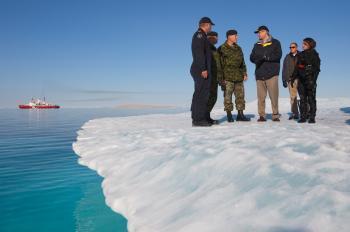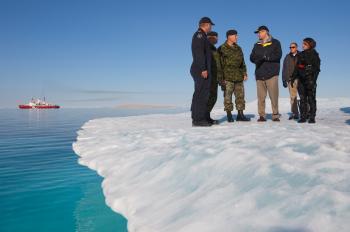Russian fighter jets caused a stir near Canadian air space as Prime Minister Stephen Harper continued on his annual tour of the North, which includes various photo ops and announcements, such as funding for critical space surveillance satellites.
On Tuesday, two CF-18 Hornet fighter aircraft were launched to meet and shadow two Russian bombers, both TU-95 Bears, approximately 120 nautical miles north of Inuvik, Northwest Territories.
The Russians reached 30 nautical miles from Canadian soil. The CF-18s launched from 4 Wing Cold Lake, Alberta, and followed the bombers until they turned around and flew back to Russia.
A statement from the Prime Minister’s Office (PMO) suggested the fighter jets kept the Russian bombers from entering Canadian airspace. NORAD has said such manoeuvres are routine and was conducting its own test exercises the same day over Central California, a possible trigger for the Russian manoeuvres.
The PMO has used the incident as an example of why it has moved forward with a single-source contract for 65 F-35 fighter jets worth billions—$9 billion to purchase and as much to maintain.
“The Harper Government has ensured our Forces have the tools, the readiness and the personnel to continue to meet any challenges to Canadian sovereignty with a robust response,” said a statement from the PMO.
“This is true today, it will be true tomorrow and it will be true well into the future.”
The statement describes the CF-18 as an “incredible aircraft” that will be replaced by the “highly capable and technologically-advanced” F-35 fifth-generation fighter jet, a plan that has attracted criticism from the opposition parties that wanted the purchase subject to a competitive bidding process.
The Standing Committee on National Defence met on Wednesday to discuss the opposition’s request to undertake a study of the purchase.
Canada is one among nine nations participating in the program, and by doing so the government says Canadian companies will be able to bid on parts of the project.
“It is the best plane our government could provide our Forces, and when you are a pilot staring down Russian long range bombers, that’s an important fact to remember,” read the statement.
NDP defence critic Jack Harris says the government’s attempt to use the incident to support their purchase of the F-35s is fear-mongering and could spark an arms race. Ottawa says the purchase is necessary if it is going to keep up its military alliance commitments with NORAD and NATO.
Liberal MP Bryon Wilfert, vice-chair of the Standing Committee on National Defence, has said that if the government really wants to protect its claim to the North, it needs to follow through on the recommendations of the committee’s June report on Arctic sovereignty.
That report included a number of recommendations, including creating a cabinet committee of relevant ministers, including the PM, that would focus on the issue. It also prompted the government to do more to support the Inuit and Canada’s Aboriginal peoples, the population whose presence in the North best supports Canada’s claim on Arctic.
The report also called on the government to fully fund the Radarsat Constellation Mission (RCM), a system of satellites capable of detailed observations of the Arctic.
Prime Minister Stephen Harper announced support for the next phase of the RCM, a system of three advanced remote sensing satellites, while in Resolute Bay, Nunavut, on Wednesday.
“By supporting the world-class Radarsat Constellation Mission, our Government will ensure Canada maintains its role as a world leader in aerospace technology,” the Prime Minister said.
“This cutting-edge project will create highly-skilled jobs, and attract the world’s best scientists, technicians and engineers to Canada’s world-renowned space industry.”
Harper said the project has allowed Canada to defend its Arctic sovereignty, the Arctic ecosystem, and develop resources there.
“This new phase of Radarsat will ensure we stay at the forefront of these priorities,” he said.
In the North, Radarsat satellites provide one of the few ways to monitor the territories and guide ships and are a critical support for defence and security forces.
The constellation will be designed by MDA of Richmond, B.C., contracted for the work by the Canadian Space Agency.
Harper was in Resolute Bay in part to take in the annual Operation Nanook, a centrepiece of three major sovereignty operations conducted each year by the Canadian Forces in Canada’s North, said a statement.
Part of this year’s operation will involve a joint RCMP, Armed Forces, and Coast Guard training exercise aimed at preparing the agencies to cooperate to contain and remediate a possible oil tanker leak. Over 900 personnel from the Canadian Forces will participate this year.
But the committee’s report also called on the government to expedite the procurement of Arctic offshore patrol ships and the John G. Diefenbaker icebreaker. The government has said the new icebreaker will join Canada’s naval fleet by 2017.
Besides a training centre to be established in Resolute Bay, the government has also pledged to expand and re-equip the Canadian Rangers, described as the “eyes and ears” of the Canadian Forces in Canada’s remote Northern regions.
A deep water Arctic docking and refuelling station is also planned for Nanisivik, a town built to support an abandoned mine inland of Strathcona Sound in Nunavut.








